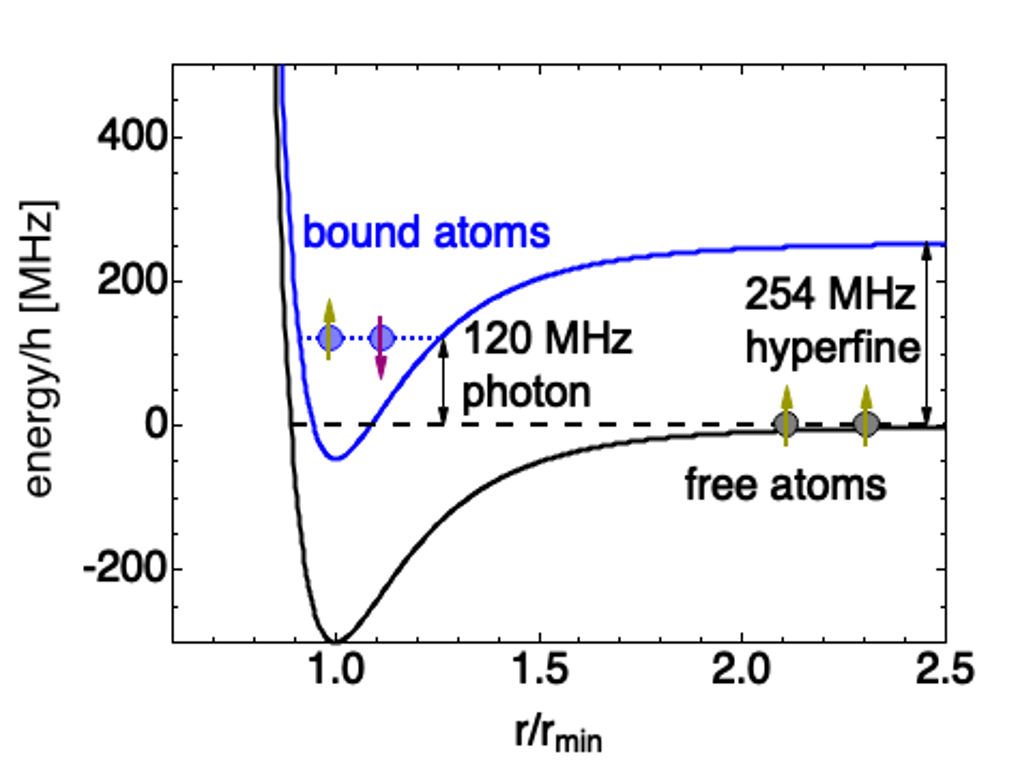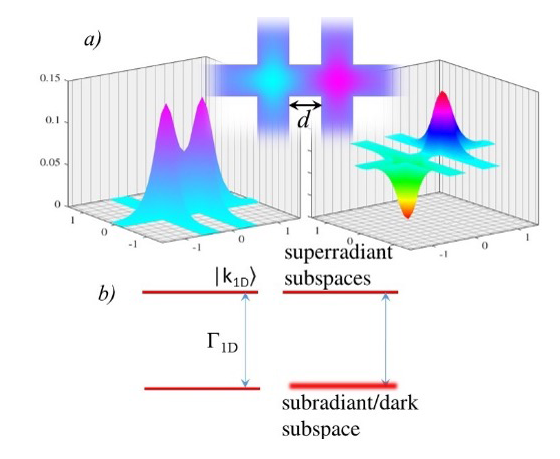FRG 3 - Quantum Information Processing
Focus Research Group 3 will utilize Bose-Einstein condensates for the implementation of quantum emulation and quantum computation, which have applications in fundamental problems of strongly correlated, many-body physics and can potentially allow quantum computation above the ultra-low temperature regime that limits current platforms.
Researchers
Current
- Jonathan Wrubel, Creighton Physics (group leader)
- Jeremy Armstrong, UNK Physics
- Wai-Ning Mei, UNO Physics
- Renat Sabirianov, UNO Physics
- Alexander Sinitskii, UNL Physics
- Thomas Wong, Creighton Physics
- Aleksander Wysocki, UNK Physics
Former
- Wei Bao
Research Thrust 1:
Quantum Emulation
Bose Einstein condensates (BECs) are ideal platforms for working out the consequences of a wide variety of ideal quantum Hamiltonians. This kind of quantum emulation uses the BEC to simulate phases or physics relevant to other more complicated systems that cannot be calculated easily with digital computers. BECs are powerful tools for quantum emulation because they form effectively zero-temperature quantum materials with perfect coherence. These complex quantum systems will be explored experimentally in ultracold atoms and in exciton-polaritons, as well as explored theoretically.

Research Thrust 2:
Quantum Computation
Quantum computers are known to outperform classical computers at a variety of tasks, including breaking public-key cryptographic systems, searching databases, and finding approximate solutions to optimization problems. Governments across the world have recognized quantum computing's potential for ushering a technological revolution by passing strategic legislation funding for its research and development. In the U.S., the National Quantum Initiative Act was passed by Congress in December 2018 and quickly signed into law. In this thrust, FRG 3 proposes to investigate quantum algorithms based on quantum walks and a new qubit based on crosswire quantum dots.

FRG 3 Selected Publications
- Ahmad Telfah, Qais M. Al-Bataineh, Belal Salameh, Ahmad A. Ahmad, Ahmad M. Alsaad, R.F. Sabirianov, “Dielectric relaxation, optical and structural characterizations of complex composite films based on polyethylene oxide doped by low concentration of iodine,” Physica B: Condensed Matter 654, 414649 (Pgs. 1-9) (2023); DOI: 10.1016/j.physb.2023.414649.
- Nabil Al Aqtash, Ahmad Alsaad, Anas Y. Al-Reyahi, Hao Zeng and Renat F. Sabirianov, “Effect of transition metals doping in magnetic properties of Fe3Se4,” Computational Condensed Matter 37, e00842 (Pgs. 1-5) (2023); https://doi.org/10.1016/j.cocom.2023.e00842.
- Saman Bagheri, Alexey Lipatov, Nataliia S. Vorobeva and Alexander Sinitskii, “Interlayer Incorporation of A-Elements into MXenes Via Selective Etching of A′ from Mn+1A′1–xA″xCn MAX Phases,” ACS Nano 17 (19), 18747–18757 (2023); https://doi.org/10.1021/acsnano.3c02198.
- Saman Bagheri, Jehad Abourahma, Haidong Lu, Nataliia S. Vorobeva, Shengyuan Luo, Alexei Gruverman and Alexander Sinitskii, “High-yield fabrication of electromechanical devices based on suspended Ti3C2Tx MXene monolayers,” Nanoscale 15, 1248-1259 (2023); DOI: 10.1039/D2NR05493K.
- Michael J. Loes, Saman Bagheri, Nataliia S. Vorobeva, Jehad Abourahma and Alexander Sinitskii, “Synergistic Effect of TiS3 and Ti3C2Tx MXene for Temperature-Tunable p-/n-Type Gas Sensing,” ACS Appl. Nano Mater. 6 (11), 9226–9235 (2023); https://doi.org/10.1021/acsanm.3c00788.
- Michael J. Loes, Alexey Lipatov, Nataliia S. Vorobeva, Haidong Lu, Jehad Abourahma, Dmitry S. Muratov, Alexei Gruverman, and Alexander Sinitskii, “Enhanced Photoresponse in Few-Layer SnS2 Field-Effect Transistors Modified with Methylammonium Lead Iodide Perovskite,” ACS Appl. Electron. Mater. 5 (2), 705–713 (2023); https://doi.org/10.1021/acsaelm.2c00947.
- Saman Bagheri, Rylan Chilcott, Shengyuan Luo, and Alexander Sinitskii, “Bifunctional Amine- and Thiol-Modified Ti3C2Tx MXene for Trace Detection of Heavy Metals,” Langmuir 38 (42), 12924–12934 (2022); https://doi.org/10.1021/acs.langmuir.2c02058.
- Haidong Lu, Hugo Aramberri, Alexey Lipatov, Roger Proksch, Alexander Sinitskii, Jorge Íñiguez and Alexei Gruverman, “Unraveling Piezoelectricity of Two-Dimensional Ferroelectric Metal 1T′′-MoS2,” ACS Materials Letters 5 (11), 3136-3141 (2023); DOI: 10.1021/acsmaterialslett.3c01051.
- Archit Dhingra, Dmitri E. Nikonov, Alexey Lipatov, Alexander Sinitskii and Peter A. Dowben, “What happens when transition metal trichalcogenides are interfaced with gold?,” Journal of Materials Research 38, 52–68 (2023); https://doi.org/10.1557/s43578-022-00744-6.
- Yibo Wang, Sajib Kumar Saha, Tianlin Li, Yanwei Xiong, Kyle Wilkin, Anil Adhikari, Michael Loes, Jehad Abourahma, Xia Hong, Shireen Adenwalla, Alexander Sinitskii and Martin Centurion, “Ultrafast electron diffraction instrument for gas and condensed matter samples,” Rev. Sci. Instrum. 94, 053001 (Pgs. 1-7) (2023); DOI: 10.1063/5.0146577.
- Thilini K. Ekanayaka, Dylan Richmond, Mason McCormick, Shashank R. Nandyala, Halle C. Helfrich, Alexander Sinitskii, Jon M. Pikal, Carolina C. Ilie, Peter A. Dowben and Andrew J. Yost, “Surface Versus Bulk State Transitions in Inkjet-Printed All-Inorganic Perovskite Quantum Dot Films,” Nanomaterials 12, 3956 (Pgs. 1-17) (2022); https://doi.org/10.3390/nano12223956.
- Haidong Lu, Shehr Bano Masood, Michael Loes, Khimananda Acharya, Md. Sazzad Hossain, Rashmeet K. Khurana, Saman Bagheri, Tula R. Paudel, Alexey Lipatov, Evgeny Y. Tsymbal, Alexander Sinitskii and Alexei Gruverman, “3D Domain Arrangement in van der Waals Ferroelectric α-In2Se3,” Adv. Funct. Mater. 2403537 (Pgs. 1-8) (2024) (early view on-line version); https://doi.org/10.1002/adfm.202403537.
- Alexey Lipatov, Jehad Abourahma, Gauthami Viswan, Khimananda Acharya, Tula R. Paudel, Michael J. Loes, Saman Bagheri, Alpha T. N'Diaye, Esha Mishra, Thilini Kumari Ekanayaka, Mohammad Zaz, Jack Rodenburg, Archit Dhingra, Robert Streubel, Peter A. Dowben and Alexander Sinitskii, “Electronic transport and polarization-dependent photoresponse in few-layered hafnium trisulfide (HfS3) nanoribbons,” J. Mater. Chem. C 11, 9425-9437 (2023); DOI: 10.1039/d3tc00773a.
- Christina Dugan, Lu Wang, Kai Zhang, J. Matthew Mann, Martin Kimani, Wai-Ning Mei, Peter A. Dowben, James Petrosky, “Interband transitions and critical points of single crystal thoria compared to Urania,” Physica Status Solidi B 259, 2200238 (2022); DOI: 10.1002/pssb.202200238.
- Elena Echeverria, John McClory, Lauren Samson, Katherine Shene, Juan A. Colón Santana, Yaroslav Burak, Volodymyr Adamiv, Ihor Teslyuk, Lu Wang, Wai-Ning Mei, Kyle A. Nelson, Douglas S. McGregor, Peter A. Dowben, Carolina C. Ilie, James Petrosky, Archit Dhingra, “Lithium tetraborate as a neutron scintillation detector: a Review,” Crystals 14 (1), 61 (Pgs. 1-17) (2024); DOI: 10.3390/cryst14010061.
- Ahmad Telfah, Z. Charifi, N. latelli, Issam A. Qattan, H. Baaziz, Qais M. Al-Bataineh, A. M. Alsaad and R. F. Sabirianov, “Formation of hydrogen bonding network of methane sulfonic acid at low degree of hydration (MSA)m·(H2O)n (m = 1–2 and n = 1–5),” Sci. Rep. 14, 11252 (2024); https://doi.org/10.1038/s41598-024-61364-0.
- Alexey Lipatov, Saman Bagheri and Alexander Sinitskii, “Metallic Conductivity of Ti3C2Tx MXene Confirmed by Temperature-Dependent Electrical Measurements,” ACS Materials Letters 6 (1), 298-307 (2024); DOI: 10.1021/acsmaterialslett.3c01234.
- Simeon J. Gilbert, Hemian Yi, Tula Paudel, Alexey Lipatov, Andrew J. Yost, Alexander Sinitskii, Evgeny Y. Tsymbal, Jose Avila, Maria C. Asensio and Peter A. Dowben, “Strong Metal−Sulfur Hybridization in the Conduction Band of the Quasi-One-Dimensional Transition-Metal Trichalcogenides: TiS3 and ZrS3,” J. Phys. Chem. C 126, 17647−17655 (2022); https://doi.org/10.1021/acs.jpcc.2c05589.
- Renjie Tao, Kai Peng, Louis Haeberlé, Quanwei Li, Dafei Jin, Graham R. Fleming, Stéphane Kéna-Cohen, Xiang Zhang, Wei Bao. (2022) Halide perovskites enable polaritonic XY spin Hamiltonian at room temperature. Nature Materials 21 716-766
- Kai Peng, Renjie Tao, Louis Haeberlé, Quanwei Li, Dafei Jin, Graham R. Fleming, Stéphane Kéna-Cohen, Xiang Zhang, Wei Bao. (2022) Room-temperature polariton quantum fluids in halide perovskites. Nature Communications 13 7388
- Ghellab, T. and Baaziz, H. and Charifi, Z. and Telfah, M. and Alsaad, A. and Telfah, A. and Hergenröder, R. and Sabirianov, R. (2022). The structural, electronic, optical, thermodynamical and thermoelectric properties of the BiAlSe compound for solar photovoltaic semiconductors. Materials Science in Semiconductor Processing. 141 (C) 106415. doi.org/10.1016/j.mssp.2021.106415
- Ghellab, T. and Baaziz, H. and Charifi, Z. and Latelli, H. and Ahmad, Mais Jamil and Telfah, Mahmoud and Alsaad, Ahmad and Telfah, Ahmad and Hergenröder, Roland and Sabirianov, Renat. (2022). First-principles calculations of the high-pressure behavior, electronic, magnetic, and elastic properties of praseodymium pnictides: PrX (X = P, As and Bi). Journal of Magnetism and Magnetic Materials. 546 (C) doi.org/10.1016/j.jmmm.2021.168919
- Bian, Mengying and Zhu, Liang and Wang, Xiao and Choi, Junho and Chopdekar, Rajesh V. and Wei, Sichen and Wu, Lishu and Huai, Chang and Marga, Austin and Yang, Qishuo and Li, Yuguang C. and Yao, Fei and Yu, Ting and Crooker, Scott A. and Cheng, Xuemei M. and Sabirianov, Renat F. and Zhang, Shengbai and Lin, Junhao and Hou, Yanglong and Zeng, Hao. (2022). Dative Epitaxy of Commensurate Monocrystalline Covalent van der Waals Moiré Supercrystal. Advanced Materials. 34 (17) Article No. 2200117. doi.org/10.1002/adma.202200117
- Ahmad Alsaad, Ahmad Telfah, Hakim Baaziz, T. Ghellab, Z. Charifi, Sahar Abdalla, Wai-Ning Mei and Renat Sabirianov, “Ab initio Investigation of Mechanical, Electronic and Optical Properties in the Orthorhombic CsPbI3 Inorganic Perovskite,” Materials Science in Semiconductor Processing 177, 108375 (Pgs. 1-9) (2024); https://doi.org/10.1016/j.mssp.2024.108375.